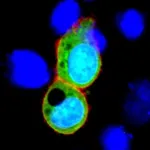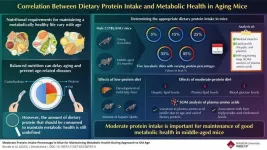(Press-News.org) A team of researchers has created a new class of titanium alloys that are strong and not brittle under tension, by integrating alloy and 3D-printing process designs.
The breakthrough, published in the top journal Nature, could help extend the applications of titanium alloys, improve sustainability and drive innovative alloy design.
Their discovery holds promise for a new class of more sustainable high-performance titanium alloys for applications in aerospace, biomedical, chemical engineering, space and energy technologies.
RMIT University and the University of Sydney led the innovation, in collaboration with Hong Kong Polytechnic University and the company Hexagon Manufacturing Intelligence in Melbourne.
Lead researcher Distinguished Professor Ma Qian from RMIT said the team embedded circular economy thinking in their design, creating great promise for producing their new titanium alloys from industrial waste and low-grade materials.
“Reusing waste and low-quality materials has the potential to add economic value and reduce the high carbon footprint of the titanium industry,” said Qian from RMIT’s Centre for Additive Manufacturing in the School of Engineering.
What type of titanium alloys has the team made?
The team’s titanium alloys consist of a mixture of two forms of titanium crystals, called alpha-titanium phase and beta-titanium phase, each corresponding to a specific arrangement of atoms.
This class of alloys has been the backbone of the titanium industry. Since 1954, these alloys have been produced primarily by adding aluminum and vanadium to titanium.
The research team investigated the use of oxygen and iron – two of the most powerful stabilisers and strengtheners of alpha- and beta-titanium phases – which are abundant and inexpensive.
Two challenges have hindered the development of strong and ductile alpha-beta titanium-oxygen-iron alloys through the conventional manufacturing processes, Qian said.
“One challenge is that oxygen – described colloquially as ‘the kryptonite to titanium’ – can make titanium brittle, and the other is that adding iron could lead to serious defects in the form of large patches of beta-titanium.”
The team used Laser Directed Energy Deposition (L-DED), a 3D printing process suitable for making large, complex parts, to print their alloys from metal powder.
“A key enabler for us was the combination of our alloy design concepts with 3D-printing process design, which has identified a range of alloys that are strong, ductile and easy to print,” Qian said.
The attractive properties of these new alloys that can rival those of commercial alloys are attributed to their microstructure, the team says.
“This research delivers a new titanium alloy system capable of a wide and tunable range of mechanical properties, high manufacturability, enormous potential for emissions reduction and insights for materials design in kindred systems,” said co-lead researcher University of Sydney Pro-Vice-Chancellor Professor Simon Ringer.
“The critical enabler is the unique distribution of oxygen and iron atoms within and between the alpha-titanium and beta-titanium phases.
“We've engineered a nanoscale gradient of oxygen in the alpha-titanium phase, featuring high-oxygen segments that are strong, and low-oxygen segments that are ductile allowing us to exert control over the local atomic bonding and so mitigate the potential for embrittlement.”
What are the potential applications of the research findings?
Lead author Dr Tingting Song, RMIT Vice-Chancellor’s Research Fellow, said the team is “at the start of a major journey, from the proof of our new concepts here, towards industrial applications”.
“There are grounds to be excited – 3D printing offers a fundamentally different way of making novel alloys and has distinct advantages over traditional approaches,” she said.
“There’s a potential opportunity for industry to reuse waste sponge titanium-oxygen-iron alloy, ‘out-of-spec’ recycled high-oxygen titanium powders or titanium powders made from high-oxygen scrap titanium using our approach.”
Co-lead author Dr Zibin Chen, who joined Hong Kong Polytechnic University from the University of Sydney in the later stages of the collaboration, said the research had broader implications.
“Oxygen embrittlement is a major metallurgical challenge not only for titanium, but also for other important metals such as zirconium, niobium and molybdenum and their alloys,” he said.
“Our work may provide a template to mitigate these oxygen embrittlement issues through 3D printing and microstructure design.”
Support for this research
The team’s work benefited from sustained, targeted investment in research infrastructure from national and state governments and from universities, Professor Ringer said.
“In many ways, this work showcases the power of Australia's national collaborative research infrastructure strategy and sets the scene for extending this strategy into the realm of advanced manufacturing,” he said.
The Australia Research Council (ARC) through the Discovery Program and the Training Centre in Surface Engineering for Advanced Materials (SEAM) funded and supported this research.
The team acknowledges support from the Australia–US Multidisciplinary University Research Initiative program supported by the Australian Government; The Hong Kong Polytechnic University; the State Key Laboratories in Hong Kong from the Innovation and Technology Commission of the Government; and Hexagon Manufacturing Intelligence for its Simufact DED solution used in the L-DED process design.
The team’s research paper, ‘Strong and ductile titanium-oxygen-iron alloys by additive manufacturing’, is published in Nature (DOI: 10.1038/s41586-023-05952-6).
Note: Once the paper has been published online, it will be available at the following URL: https://www.nature.com/articles/s41586-023-05952-6. This link will go live after the embargo ends.
An editorial on the team’s work, ‘Designer titanium alloys created using 3D printing’, is published in Nature (DOI: 10.1038/d41586-023-01360-y). * We adopted the term ‘designer titanium’ in this media release from this editorial article in Nature.
MULTIMEDIA FOR MEDIA USE
Images and videos related to this story are available to download via this link: https://cloudstor.aarnet.edu.au/plus/s/YNO0hkLWZMGeEFy
END
New ‘designer’ titanium alloys made using 3D printing
2023-05-31
ELSE PRESS RELEASES FROM THIS DATE:
A protein mines, sorts rare earths better than humans, paving way for green tech
2023-05-31
UNIVERSITY PARK, Pa. — Rare earth elements, like neodymium and dysprosium, are a critical component to almost all modern technologies, from smartphones to hard drives, but they are notoriously hard to separate from the Earth’s crust and from one another.
Penn State scientists have discovered a new mechanism by which bacteria can select between different rare earth elements, using the ability of a bacterial protein to bind to another unit of itself, or “dimerize,” when it is bound to certain rare earths, but prefer to remain a single unit, or “monomer,” ...
First-of-its-kind open-analysis platform for pediatric brain tumors provides robust data resource for childhood cancer research
2023-05-31
Philadelphia, May 31, 2023 – Researchers from Children’s Hospital of Philadelphia (CHOP), the Alex’s Lemonade Stand Foundation Childhood Cancer Data Lab, the Children’s Brain Tumor Network (CBTN), the Pacific Pediatric Neuro-Oncology Consortium (PNOC), and more than 20 additional institutions have partnered to create a first-of-its-kind open-source, reproducible analysis platform for pediatric brain tumors. With the help of thousands of genomically sequenced samples, researchers have used this platform to identify initial findings about genetic variants associated with poorer outcomes that could help guide future diagnostic and therapeutic advances.
The ...
Scientists’ report world’s first X-ray of a single atom in Nature
2023-05-31
A team of scientists from Ohio University, Argonne National Laboratory, the University of Illinois-Chicago, and others, led by Ohio University Professor of Physics, and Argonne National Laboratory scientist, Saw Wai Hla, have taken the world’s first X-ray SIGNAL (or SIGNATURE) of just one atom. This groundbreaking achievement was funded by the U.S. Department of Energy, Office of Basic Energy Sciences and could revolutionize the way scientists detect the materials.
Since its discovery by Roentgen ...
Phenomenal phytoplankton: Scientists uncover cellular process behind oxygen production
2023-05-31
Take a deep breath. Now take nine more. According to new research, the amount of oxygen in one of those 10 breaths was made possible thanks to a newly identified cellular mechanism that promotes photosynthesis in marine phytoplankton.
Described as “groundbreaking” by a team of researchers at UC San Diego’s Scripps Institution of Oceanography, this previously unknown process accounts for between 7% to 25% of all the oxygen produced and carbon fixed in the ocean. When also considering photosynthesis occuring on land, researchers estimated that this mechanism could be responsible for generating ...
The world's fastest electron microscope
2023-05-31
Electron microscopes give us insight into the tiniest details of materials and can visualize, for example, the structure of solids, molecules or nanoparticles with atomic resolution. However, most materials in nature are not static. They constantly interact, move and reshape between initial and final configurations. One of the most general phenomena is the interaction between light and matter, which is omnipresent in materials such as solar cells, displays or lasers. These interactions are defined by electrons pushed and pulled around by the oscillations of light, and the dynamics are extremely fast: light waves oscillate at attoseconds, the billionth of a billionth ...
Can we learn to think further ahead?
2023-05-31
Chess grandmasters are often held up as the epitome of thinking far ahead. But can others, with a modest amount of practice, learn to think further ahead?
In addressing this question, a team of cognitive scientists has created a computational model that reveals our ability to plan for future events. The work enhances our understanding of the factors that affect decision-making and shows how we can boost our planning skills through practice.
The research, conducted by scientists in New York University’s Center for Neural Science and ...
Further link identified between autoimmunity and schizophrenia
2023-05-31
Researchers from Tokyo Medical and Dental University (TMDU) identify a protein in some people with schizophrenia that causes schizophrenia-like features in mice
Tokyo, Japan – Links have been reported between schizophrenia and proteins produced by the immune system that can act against one’s own body, known as autoantibodies. In a study published last month in Brain Behavior and Immunity, Japanese researchers identified autoantibodies that target a ‘synaptic adhesion protein’, neurexin 1α, in a subset of patients with schizophrenia. When injected into mice, the ...
New study unveils nanocrystal shines on and off indefinitely
2023-05-31
A research team affiliated with UNIST has made a significant breakthrough in uncovering the potential of ultra-photostable avalanching nanoparticles (ANP). Their study demonstrates that such particles can perform unlimited photoswitching, leading to new advancements in fields like optical probes, 3D optical memory, and super-resolution microscopy.
This breakthrough has been achieved through the efforts of Professor Yung Doug Suh and his research team in the Department of Chemistry at Ulsan National Institute of Science and Technology (UNIST), in collaboration with researchers from Columbia University and ...
A nanocrystal shines on and off indefinitely
2023-05-31
New York, NY—May 31, 2023—In 2021, lanthanide-doped nanoparticles made waves—or rather, an avalanche—when Changwan Lee, then a PhD student in Jim Schuck’s lab at Columbia Engineering, set off an extreme light-producing chain reaction from ultrasmall crystals developed at the Molecular Foundry at Berkeley Lab. Those same crystals are back again with a blink that can now be deliberately and indefinitely controlled.
“We’ve found the first fully photostable, fully photoswitchable nanoparticle—a holy grail of nanoprobe design,” said Schuck, associate ...
Eat right, live longer: could a moderate protein diet be the coveted elixir of youth?
2023-05-31
As the proverb “You are what you eat” goes, the type of food we consume influences our health and longevity all through our lives. In fact, there is a direct association between age-related nutritional requirements and metabolic health. Optimal nutrition according to age can help maintain metabolic health, thereby improving the health span (period of life without diseases) and lifespan of an individual. Different nutritional interventions involving varied calorie and protein intake have been known to improve the health and lifespan of rodents and primates. Furthermore, recent studies have also reported the association of dietary macronutrients (proteins, ...










